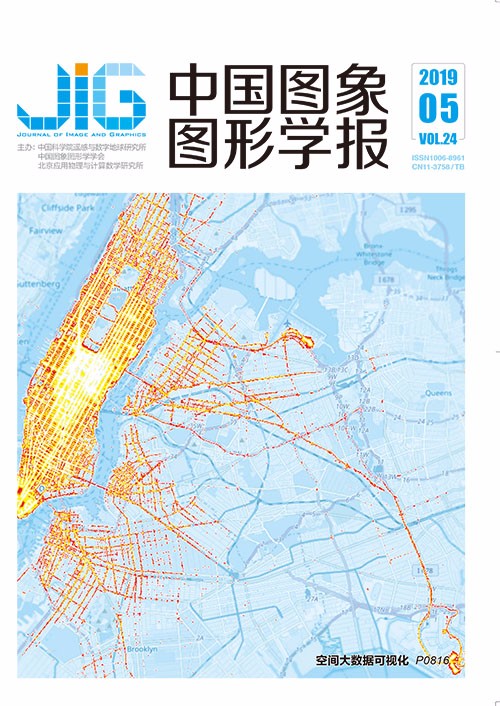
引入初级视通路计算模型的轮廓检测
摘 要
目的 轮廓是对图像目标的一种稀疏表达方式,从图像中提取出有效物体轮廓可以更好地完成后续的视觉认知任务,所以轮廓检测在计算机视觉领域具有较好的应用。本文考虑到初级视通路中视觉信息传递和处理流程中的特点,提出了一种基于初级视通路计算模型的轮廓检测方法。方法 在视网膜神经节环节,提出一种体现方向选择特性的经典感受野(CRF)改进模型,利用多尺度特征融合策略来模拟视网膜神经节细胞对图像目标的初级轮廓响应;在视网膜神经节到神经节-外膝体(LGN)的视通路中,提出一种反映视觉信息时空尺度特征的时空编码机制,模拟神经节-外膝体通路对初级轮廓响应的去冗余处理;利用非下采样轮廓波变换和Gabor变换协同作用,模拟非经典感受野(NCRF)的侧向抑制特性。最后利用初级视皮层对整体轮廓的前馈机制,实现对轮廓局部细节信息的完整性融合。结果 选择将RuG40图库的所有图像作为测试集合进行模型性能测试,对检测结果进行非极大值抑制和阈值处理,最终将得到的二值轮廓图与基准图比较,整个数据集和单张图的最优平均P指标分别为0.49和0.56。对于单个图像最优参数条件下的检测结果均值,将本文方法与非经典感受野抑制模型(ISO)和多特征外周抑制模型(MCI)比较,较两者分别提高了19.1%和7.7%。结果表明本文方法能有效突出主体轮廓并抑制纹理背景。结论 面向图像处理应用的初级视通路计算模型,将为后续图像理解和分析提供一种新的思路。
关键词
Contour detection based on a computation model for primary visual pathway
Wu Wei, Zhou Tao, Zhu Yaping, Fan Yingle(School of Automation, Hangzhou Dianzi University, Hangzhou 310018, China) Abstract
Objective The effectiveness of contour detection in many applications has been well established and demonstrated widely. This operation is fundamental for numerous vision tasks, such as image analysis and scene understanding. The operation can be used for image segmentation, object detection, and occlusion and depth reasoning. Many studies on contour detection respond not only to foreground objects but also to background textures. In this study, a new method of "object-only" contour detection based on the primary visual pathway computation model is proposed according to the characteristics of visual information transmission and processing in the primary visual pathway. Obtaining the accurate boundaries of an object in the foreground is expected, and the noise and background textures in images are suppressed. Method In this study, we attempt to construct a primary visual pathway computation model to simulate the transmission and processing of visual information flows. First, in the retinal ganglion, a classical receptive field direction selection model that combines multi-scale features is constructed to obtain the primary contour response of image targets. Then, a spatiotemporal coding mechanism is used to streamline the redundant features in the primary contour response in the visual pathway of the retinal ganglion to the LGN (lateral geniculate nucleus). Furthermore, the synergistic effects of NSCT (non-subsampled contourlet transform) and Gabor transform are used to simulate the processing effects of the lateral suppression characteristics of NCRF (non-classical receptive field) on the texture background information. Finally, the feedforward mechanism of the visual pathway to the primary visual cortex is combined with the visual features of the multi-visual pathway to obtain the contour response. Result The experimental images are derived from RuG40. To verify the effectiveness of our proposed algorithm, we use and compare two methods (ISO and MCI) with the best contour detection results. After the non-maximum suppression and threshold processing, the binary contour map obtained is compared with the reference map. On the one hand, the qualitative analysis of the proposed algorithm shows that although the ISO method achieves a certain balance between false detection rate and missed detection rate in general, some parts present severely distorted contours, such as the image ganglions. Although the MCI method has an improved balance between false detection rate and missed detection rate, the actual detection effect is equally superior. However, its suppression of the image background must be improved in the processing effect of some complex background images, such as the Buffalo. The proposed detection model has the best detection performance under the premise of ensuring that the contour detection results are close to the manual detection results. On the other hand, the quantitative analysis of the proposed algorithm shows that the optimal average indicators for the entire data set and a single map of the RuG40 library are 0.49 and 0.56, respectively. For the average detection results of the optimal parameters of the entire library, the proposed detection model achieves an increase of 22.5% and 6.5% relative to the ISO and MCI models, respectively. For the mean values of the detection results of the optimal parameters for a single image, the proposed detection model achieves an increase of 19.1% and 7.7% relative to the ISO and MCI models, respectively. Conclusion This study attempts to construct a primary visual pathway computation model to simulate the transmission and processing of biological visual information flows. Compared with the best methods for current contour detection by ISO and MCI, the proposed algorithm can suppress texture background information to a large extent while achieving complete extraction of contour information. Moreover, the proposed algorithm is close to the biological vision mechanism. The contour detection method put forward in this study provides a new research approach for the subsequent contour detection method based on the biological vision mechanism. Subsequent research can be based on the biological vision mechanism to explore how the proposed contour detection method affects advanced image understanding and perception tasks. At the same time, the proposed contour detection method can be used to provide a solid foundation for subsequent high-level visual perception technology.
Keywords
contour detection visual mechanism multi-scale feature fusion lateral inhibitory properties temporal and spatial coding
|



 中国图象图形学报 │ 京ICP备05080539号-4 │ 本系统由
中国图象图形学报 │ 京ICP备05080539号-4 │ 本系统由